Analysis of Information Technology Ethics: Early Launch Scenario
VerifiedAdded on 2021/04/21
|6
|1373
|28
Report
AI Summary
This report provides an in-depth analysis of an information technology ethics scenario, specifically focusing on an 'Early Launch' scenario where a project director pressures a project manager to release software without encryption to meet a deadline. Using the 'Doing Ethics Technique,' the report dissects the ethical issues at hand, including the prioritization of profit and deadlines over software security and user data protection. The analysis identifies key stakeholders affected by the decision, such as the client, the development team, and end-users, and explores the implications of the unethical actions, including potential data breaches and reputational damage. The report applies the Deontological ethical theory to assess the morality of the actions, emphasizing the importance of secure software development. Ultimately, the report evaluates different options and concludes that delivering the software on time with encryption is the best approach to mitigate risks and uphold ethical standards, ensuring the security and privacy of the users.
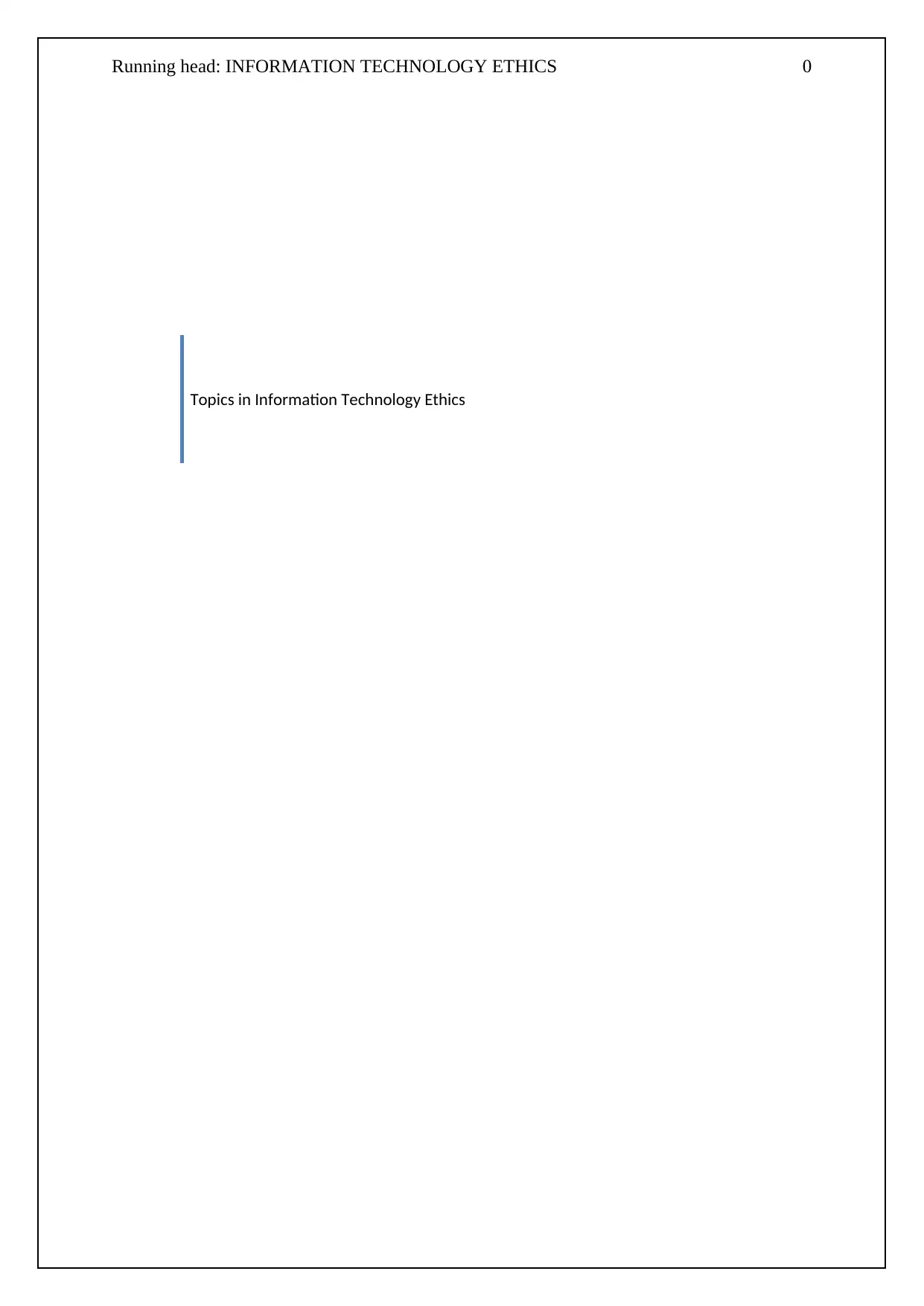
Running head: INFORMATION TECHNOLOGY ETHICS 0
Topics in Information Technology Ethics
Topics in Information Technology Ethics
Paraphrase This Document
Need a fresh take? Get an instant paraphrase of this document with our AI Paraphraser
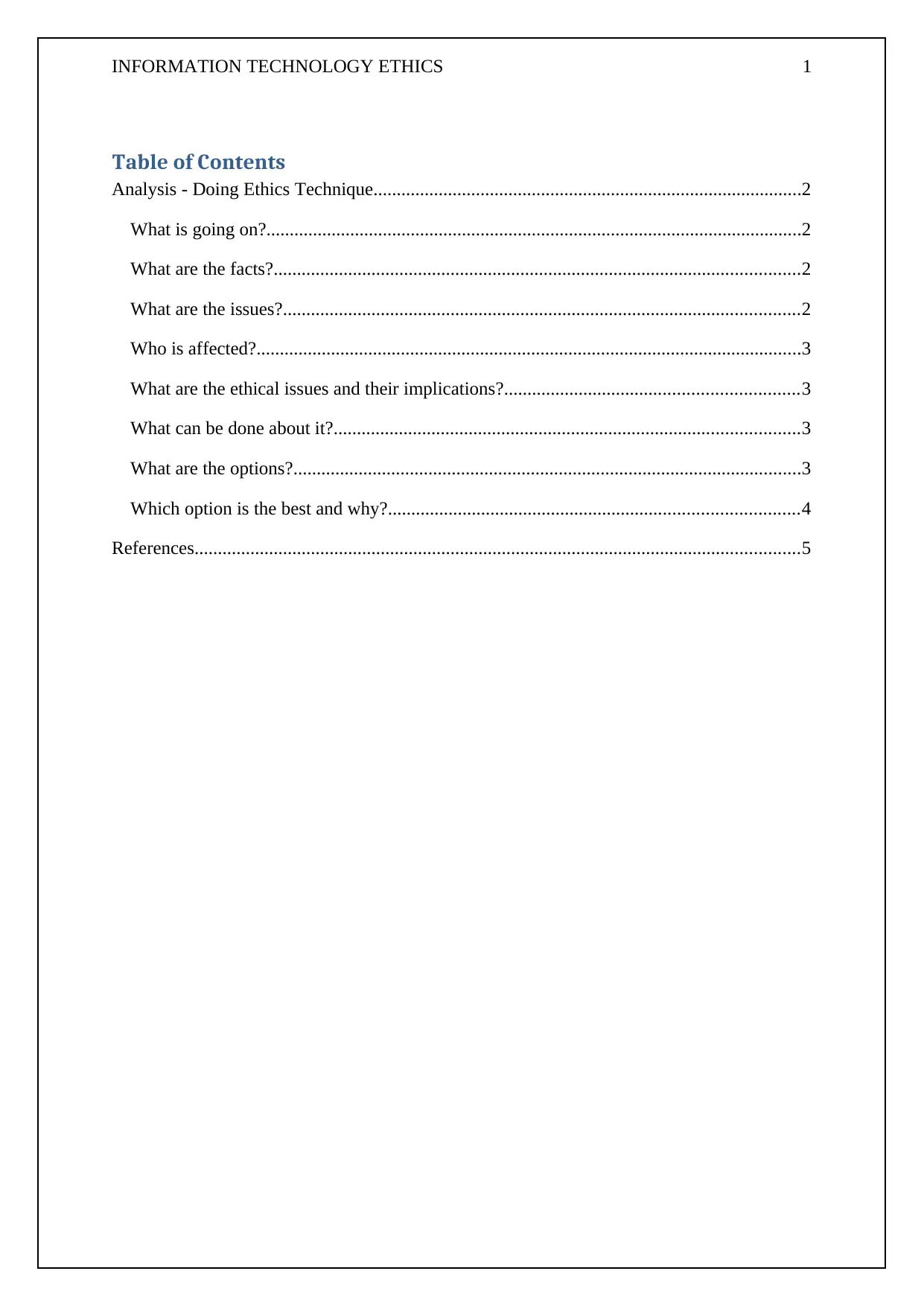
INFORMATION TECHNOLOGY ETHICS 1
Table of Contents
Analysis - Doing Ethics Technique............................................................................................2
What is going on?...................................................................................................................2
What are the facts?.................................................................................................................2
What are the issues?...............................................................................................................2
Who is affected?.....................................................................................................................3
What are the ethical issues and their implications?...............................................................3
What can be done about it?....................................................................................................3
What are the options?.............................................................................................................3
Which option is the best and why?........................................................................................4
References..................................................................................................................................5
Table of Contents
Analysis - Doing Ethics Technique............................................................................................2
What is going on?...................................................................................................................2
What are the facts?.................................................................................................................2
What are the issues?...............................................................................................................2
Who is affected?.....................................................................................................................3
What are the ethical issues and their implications?...............................................................3
What can be done about it?....................................................................................................3
What are the options?.............................................................................................................3
Which option is the best and why?........................................................................................4
References..................................................................................................................................5
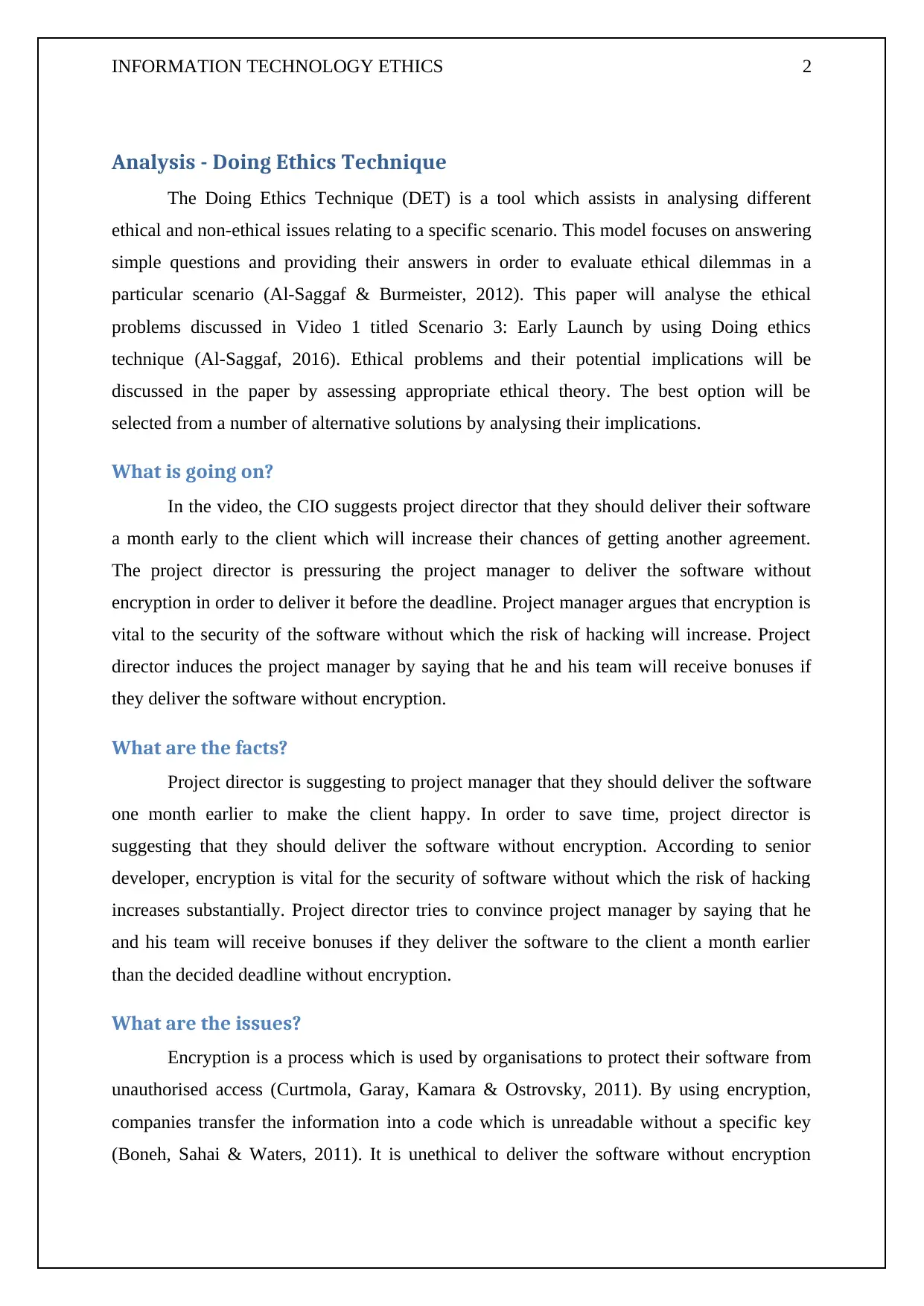
INFORMATION TECHNOLOGY ETHICS 2
Analysis - Doing Ethics Technique
The Doing Ethics Technique (DET) is a tool which assists in analysing different
ethical and non-ethical issues relating to a specific scenario. This model focuses on answering
simple questions and providing their answers in order to evaluate ethical dilemmas in a
particular scenario (Al-Saggaf & Burmeister, 2012). This paper will analyse the ethical
problems discussed in Video 1 titled Scenario 3: Early Launch by using Doing ethics
technique (Al-Saggaf, 2016). Ethical problems and their potential implications will be
discussed in the paper by assessing appropriate ethical theory. The best option will be
selected from a number of alternative solutions by analysing their implications.
What is going on?
In the video, the CIO suggests project director that they should deliver their software
a month early to the client which will increase their chances of getting another agreement.
The project director is pressuring the project manager to deliver the software without
encryption in order to deliver it before the deadline. Project manager argues that encryption is
vital to the security of the software without which the risk of hacking will increase. Project
director induces the project manager by saying that he and his team will receive bonuses if
they deliver the software without encryption.
What are the facts?
Project director is suggesting to project manager that they should deliver the software
one month earlier to make the client happy. In order to save time, project director is
suggesting that they should deliver the software without encryption. According to senior
developer, encryption is vital for the security of software without which the risk of hacking
increases substantially. Project director tries to convince project manager by saying that he
and his team will receive bonuses if they deliver the software to the client a month earlier
than the decided deadline without encryption.
What are the issues?
Encryption is a process which is used by organisations to protect their software from
unauthorised access (Curtmola, Garay, Kamara & Ostrovsky, 2011). By using encryption,
companies transfer the information into a code which is unreadable without a specific key
(Boneh, Sahai & Waters, 2011). It is unethical to deliver the software without encryption
Analysis - Doing Ethics Technique
The Doing Ethics Technique (DET) is a tool which assists in analysing different
ethical and non-ethical issues relating to a specific scenario. This model focuses on answering
simple questions and providing their answers in order to evaluate ethical dilemmas in a
particular scenario (Al-Saggaf & Burmeister, 2012). This paper will analyse the ethical
problems discussed in Video 1 titled Scenario 3: Early Launch by using Doing ethics
technique (Al-Saggaf, 2016). Ethical problems and their potential implications will be
discussed in the paper by assessing appropriate ethical theory. The best option will be
selected from a number of alternative solutions by analysing their implications.
What is going on?
In the video, the CIO suggests project director that they should deliver their software
a month early to the client which will increase their chances of getting another agreement.
The project director is pressuring the project manager to deliver the software without
encryption in order to deliver it before the deadline. Project manager argues that encryption is
vital to the security of the software without which the risk of hacking will increase. Project
director induces the project manager by saying that he and his team will receive bonuses if
they deliver the software without encryption.
What are the facts?
Project director is suggesting to project manager that they should deliver the software
one month earlier to make the client happy. In order to save time, project director is
suggesting that they should deliver the software without encryption. According to senior
developer, encryption is vital for the security of software without which the risk of hacking
increases substantially. Project director tries to convince project manager by saying that he
and his team will receive bonuses if they deliver the software to the client a month earlier
than the decided deadline without encryption.
What are the issues?
Encryption is a process which is used by organisations to protect their software from
unauthorised access (Curtmola, Garay, Kamara & Ostrovsky, 2011). By using encryption,
companies transfer the information into a code which is unreadable without a specific key
(Boneh, Sahai & Waters, 2011). It is unethical to deliver the software without encryption
⊘ This is a preview!⊘
Do you want full access?
Subscribe today to unlock all pages.

Trusted by 1+ million students worldwide
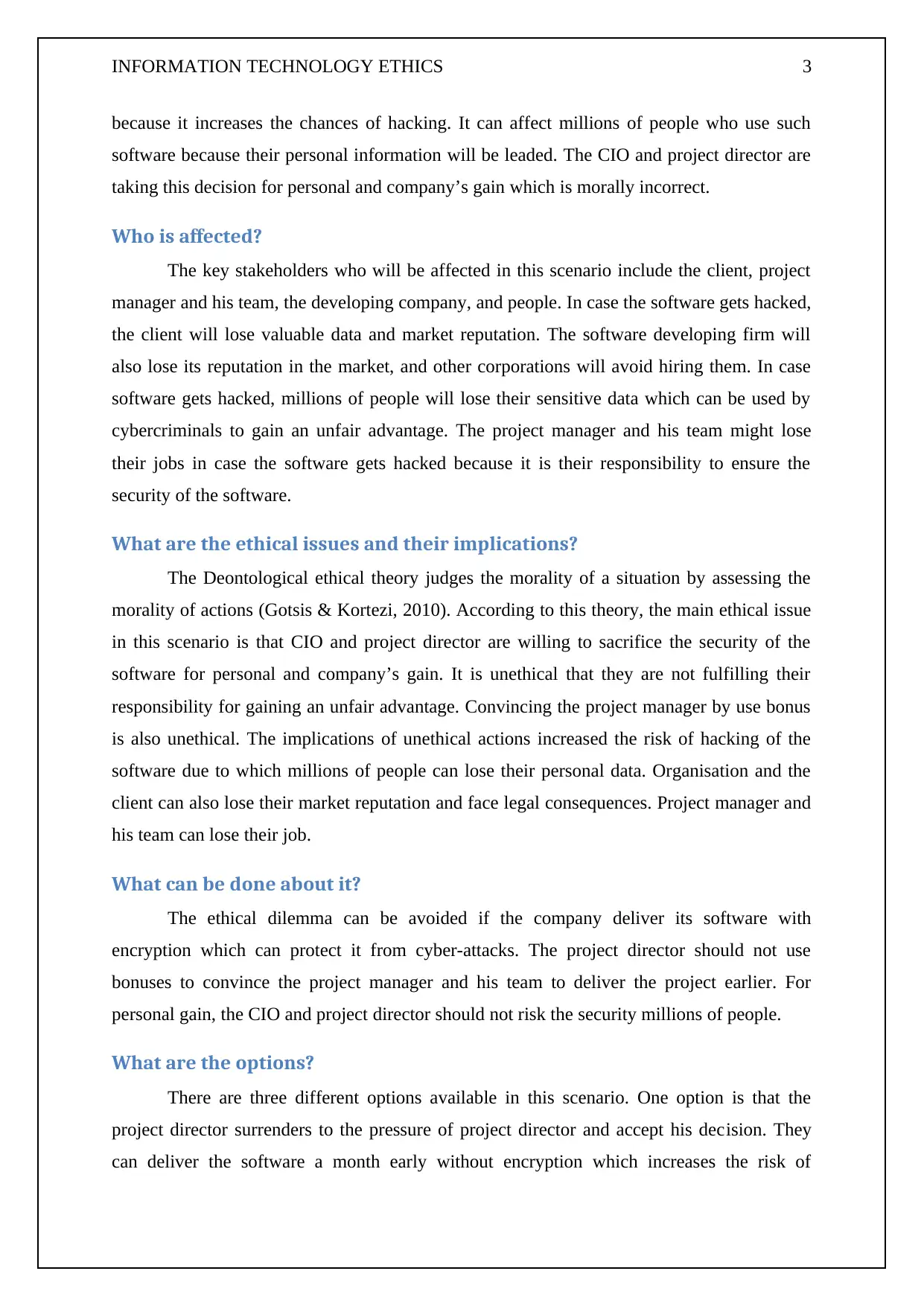
INFORMATION TECHNOLOGY ETHICS 3
because it increases the chances of hacking. It can affect millions of people who use such
software because their personal information will be leaded. The CIO and project director are
taking this decision for personal and company’s gain which is morally incorrect.
Who is affected?
The key stakeholders who will be affected in this scenario include the client, project
manager and his team, the developing company, and people. In case the software gets hacked,
the client will lose valuable data and market reputation. The software developing firm will
also lose its reputation in the market, and other corporations will avoid hiring them. In case
software gets hacked, millions of people will lose their sensitive data which can be used by
cybercriminals to gain an unfair advantage. The project manager and his team might lose
their jobs in case the software gets hacked because it is their responsibility to ensure the
security of the software.
What are the ethical issues and their implications?
The Deontological ethical theory judges the morality of a situation by assessing the
morality of actions (Gotsis & Kortezi, 2010). According to this theory, the main ethical issue
in this scenario is that CIO and project director are willing to sacrifice the security of the
software for personal and company’s gain. It is unethical that they are not fulfilling their
responsibility for gaining an unfair advantage. Convincing the project manager by use bonus
is also unethical. The implications of unethical actions increased the risk of hacking of the
software due to which millions of people can lose their personal data. Organisation and the
client can also lose their market reputation and face legal consequences. Project manager and
his team can lose their job.
What can be done about it?
The ethical dilemma can be avoided if the company deliver its software with
encryption which can protect it from cyber-attacks. The project director should not use
bonuses to convince the project manager and his team to deliver the project earlier. For
personal gain, the CIO and project director should not risk the security millions of people.
What are the options?
There are three different options available in this scenario. One option is that the
project director surrenders to the pressure of project director and accept his decision. They
can deliver the software a month early without encryption which increases the risk of
because it increases the chances of hacking. It can affect millions of people who use such
software because their personal information will be leaded. The CIO and project director are
taking this decision for personal and company’s gain which is morally incorrect.
Who is affected?
The key stakeholders who will be affected in this scenario include the client, project
manager and his team, the developing company, and people. In case the software gets hacked,
the client will lose valuable data and market reputation. The software developing firm will
also lose its reputation in the market, and other corporations will avoid hiring them. In case
software gets hacked, millions of people will lose their sensitive data which can be used by
cybercriminals to gain an unfair advantage. The project manager and his team might lose
their jobs in case the software gets hacked because it is their responsibility to ensure the
security of the software.
What are the ethical issues and their implications?
The Deontological ethical theory judges the morality of a situation by assessing the
morality of actions (Gotsis & Kortezi, 2010). According to this theory, the main ethical issue
in this scenario is that CIO and project director are willing to sacrifice the security of the
software for personal and company’s gain. It is unethical that they are not fulfilling their
responsibility for gaining an unfair advantage. Convincing the project manager by use bonus
is also unethical. The implications of unethical actions increased the risk of hacking of the
software due to which millions of people can lose their personal data. Organisation and the
client can also lose their market reputation and face legal consequences. Project manager and
his team can lose their job.
What can be done about it?
The ethical dilemma can be avoided if the company deliver its software with
encryption which can protect it from cyber-attacks. The project director should not use
bonuses to convince the project manager and his team to deliver the project earlier. For
personal gain, the CIO and project director should not risk the security millions of people.
What are the options?
There are three different options available in this scenario. One option is that the
project director surrenders to the pressure of project director and accept his decision. They
can deliver the software a month early without encryption which increases the risk of
Paraphrase This Document
Need a fresh take? Get an instant paraphrase of this document with our AI Paraphraser
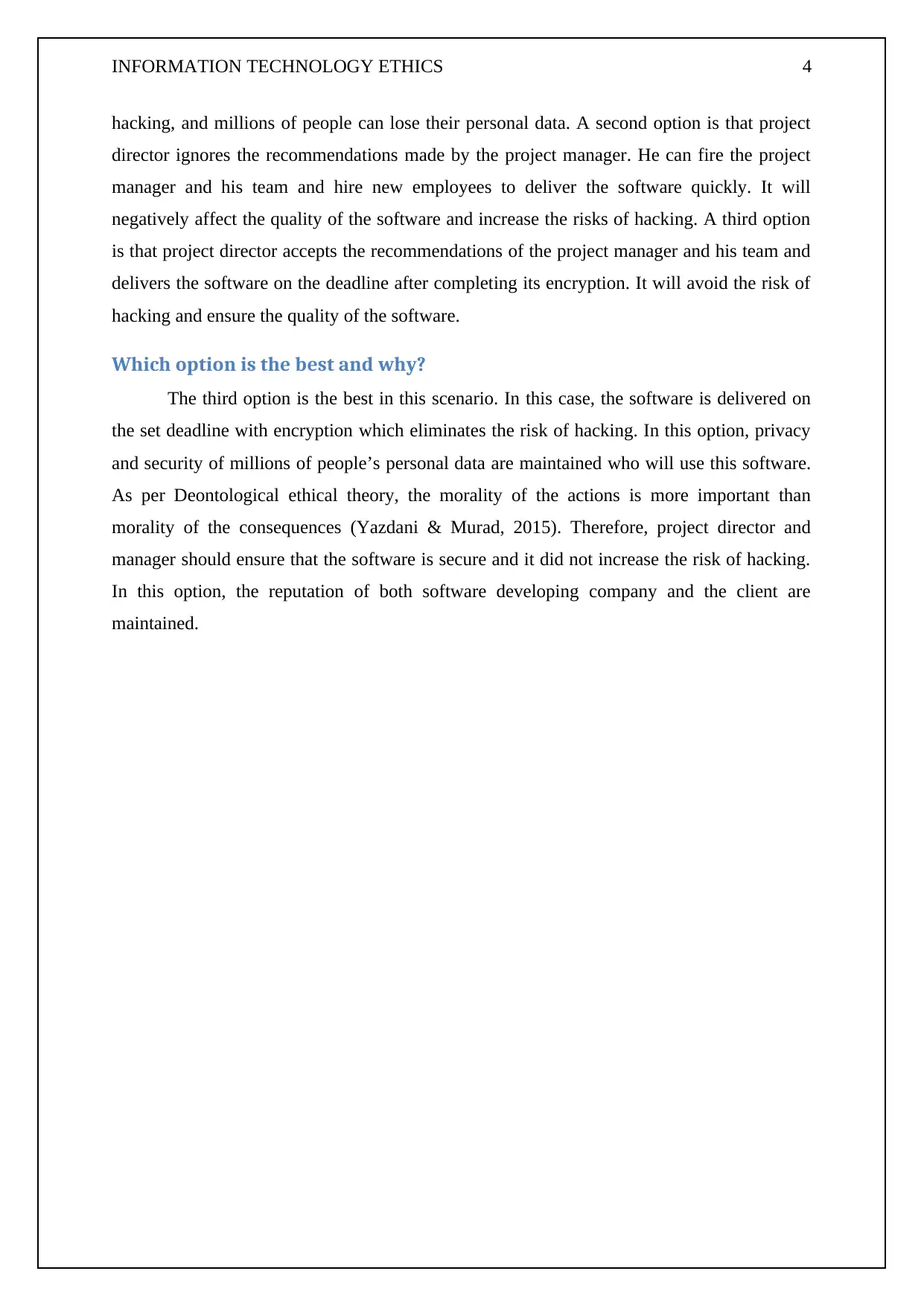
INFORMATION TECHNOLOGY ETHICS 4
hacking, and millions of people can lose their personal data. A second option is that project
director ignores the recommendations made by the project manager. He can fire the project
manager and his team and hire new employees to deliver the software quickly. It will
negatively affect the quality of the software and increase the risks of hacking. A third option
is that project director accepts the recommendations of the project manager and his team and
delivers the software on the deadline after completing its encryption. It will avoid the risk of
hacking and ensure the quality of the software.
Which option is the best and why?
The third option is the best in this scenario. In this case, the software is delivered on
the set deadline with encryption which eliminates the risk of hacking. In this option, privacy
and security of millions of people’s personal data are maintained who will use this software.
As per Deontological ethical theory, the morality of the actions is more important than
morality of the consequences (Yazdani & Murad, 2015). Therefore, project director and
manager should ensure that the software is secure and it did not increase the risk of hacking.
In this option, the reputation of both software developing company and the client are
maintained.
hacking, and millions of people can lose their personal data. A second option is that project
director ignores the recommendations made by the project manager. He can fire the project
manager and his team and hire new employees to deliver the software quickly. It will
negatively affect the quality of the software and increase the risks of hacking. A third option
is that project director accepts the recommendations of the project manager and his team and
delivers the software on the deadline after completing its encryption. It will avoid the risk of
hacking and ensure the quality of the software.
Which option is the best and why?
The third option is the best in this scenario. In this case, the software is delivered on
the set deadline with encryption which eliminates the risk of hacking. In this option, privacy
and security of millions of people’s personal data are maintained who will use this software.
As per Deontological ethical theory, the morality of the actions is more important than
morality of the consequences (Yazdani & Murad, 2015). Therefore, project director and
manager should ensure that the software is secure and it did not increase the risk of hacking.
In this option, the reputation of both software developing company and the client are
maintained.
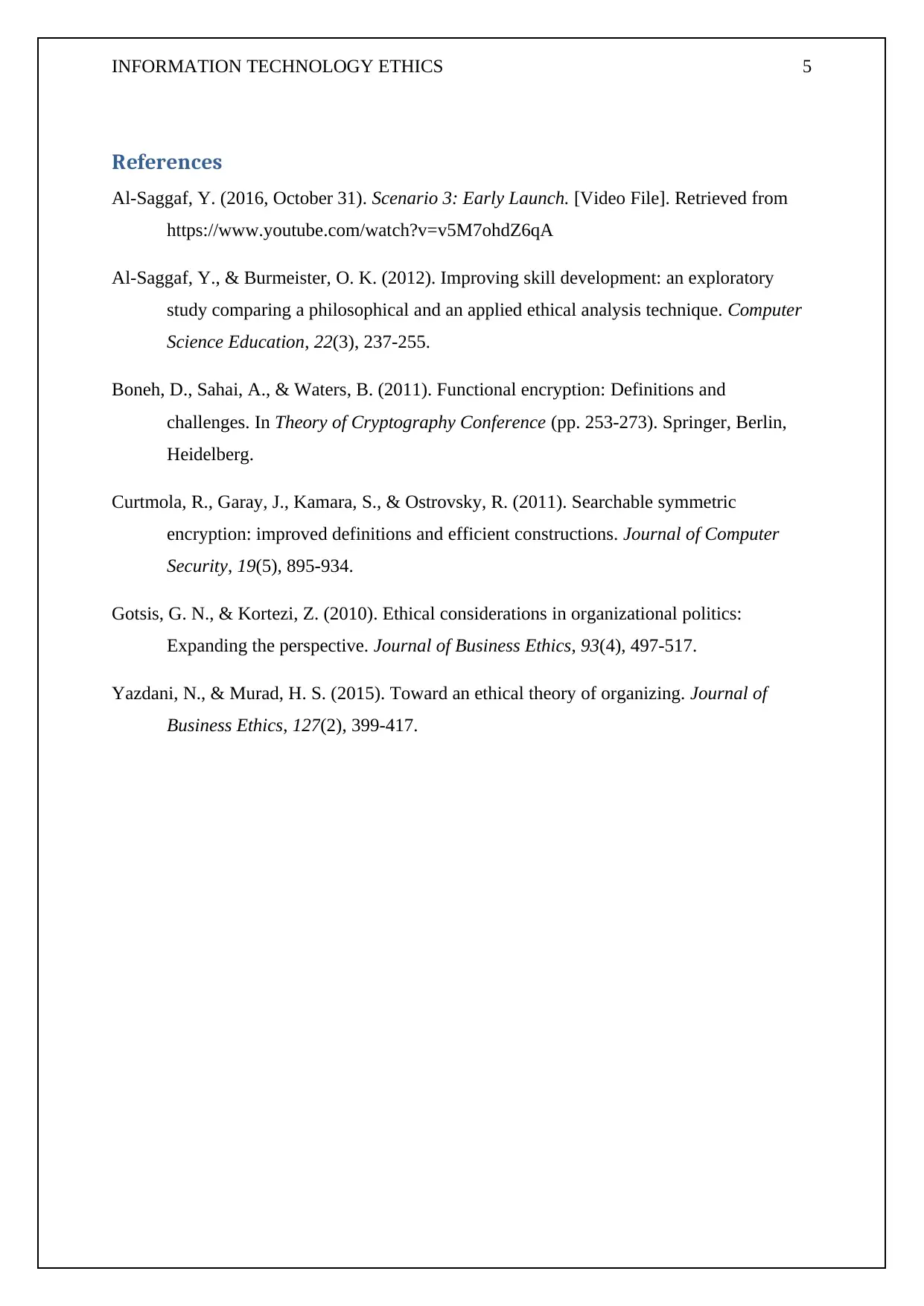
INFORMATION TECHNOLOGY ETHICS 5
References
Al-Saggaf, Y. (2016, October 31). Scenario 3: Early Launch. [Video File]. Retrieved from
https://www.youtube.com/watch?v=v5M7ohdZ6qA
Al-Saggaf, Y., & Burmeister, O. K. (2012). Improving skill development: an exploratory
study comparing a philosophical and an applied ethical analysis technique. Computer
Science Education, 22(3), 237-255.
Boneh, D., Sahai, A., & Waters, B. (2011). Functional encryption: Definitions and
challenges. In Theory of Cryptography Conference (pp. 253-273). Springer, Berlin,
Heidelberg.
Curtmola, R., Garay, J., Kamara, S., & Ostrovsky, R. (2011). Searchable symmetric
encryption: improved definitions and efficient constructions. Journal of Computer
Security, 19(5), 895-934.
Gotsis, G. N., & Kortezi, Z. (2010). Ethical considerations in organizational politics:
Expanding the perspective. Journal of Business Ethics, 93(4), 497-517.
Yazdani, N., & Murad, H. S. (2015). Toward an ethical theory of organizing. Journal of
Business Ethics, 127(2), 399-417.
References
Al-Saggaf, Y. (2016, October 31). Scenario 3: Early Launch. [Video File]. Retrieved from
https://www.youtube.com/watch?v=v5M7ohdZ6qA
Al-Saggaf, Y., & Burmeister, O. K. (2012). Improving skill development: an exploratory
study comparing a philosophical and an applied ethical analysis technique. Computer
Science Education, 22(3), 237-255.
Boneh, D., Sahai, A., & Waters, B. (2011). Functional encryption: Definitions and
challenges. In Theory of Cryptography Conference (pp. 253-273). Springer, Berlin,
Heidelberg.
Curtmola, R., Garay, J., Kamara, S., & Ostrovsky, R. (2011). Searchable symmetric
encryption: improved definitions and efficient constructions. Journal of Computer
Security, 19(5), 895-934.
Gotsis, G. N., & Kortezi, Z. (2010). Ethical considerations in organizational politics:
Expanding the perspective. Journal of Business Ethics, 93(4), 497-517.
Yazdani, N., & Murad, H. S. (2015). Toward an ethical theory of organizing. Journal of
Business Ethics, 127(2), 399-417.
⊘ This is a preview!⊘
Do you want full access?
Subscribe today to unlock all pages.

Trusted by 1+ million students worldwide
1 out of 6
Related Documents
Your All-in-One AI-Powered Toolkit for Academic Success.
+13062052269
info@desklib.com
Available 24*7 on WhatsApp / Email
![[object Object]](/_next/static/media/star-bottom.7253800d.svg)
Unlock your academic potential
Copyright © 2020–2025 A2Z Services. All Rights Reserved. Developed and managed by ZUCOL.





